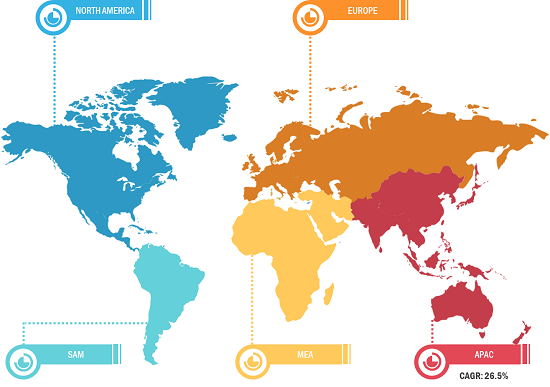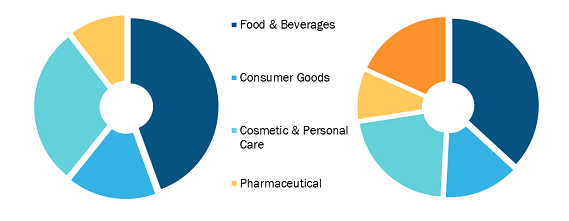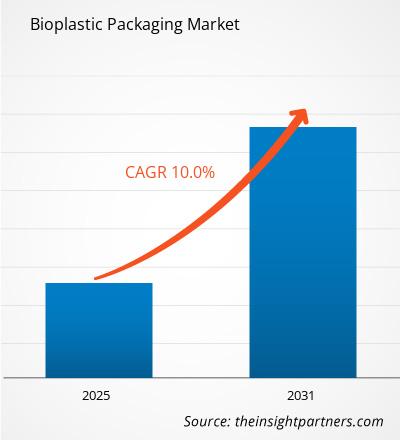من المتوقع أن يصل سوق التغليف البلاستيكي الحيوي إلى 47,991.9 مليون دولار أمريكي بحلول عام 2031 مقارنة بالدولار الأمريكي 13,273.9 مليونًا في عام 2022. ومن المتوقع أن ينمو بمعدل نمو سنوي مركب قدره 23.9% خلال الفترة من 2022 إلى 2031.
الطعام& المشروبات والسلع الاستهلاكية ومستحضرات التجميل& تعد العناية الشخصية والأدوية من بين المستخدمين النهائيين الرئيسيين للتغليف البلاستيكي الحيوي. يتم استخدام العبوات البلاستيكية على نطاق واسع في تطبيقات مختلفة مثل السلع الاستهلاكية سريعة الحركة والأغذية والمشروبات. المشروبات والأدوية والسلع الاستهلاكية. هذا الاستخدام المتزايد للبلاستيك في العديد من التطبيقات هو المسؤول عن ارتفاع التلوث البلاستيكي. وبالتالي، أصبحت إعادة تدوير البلاستيك وإعادة استخدامه أمرًا مهمًا للابتكار والاستدامة. علاوة على ذلك، من المتوقع أن يصبح البلاستيك التقليدي أكثر تكلفة في المستقبل مع تناقص مصادر المواد الخام. في السنوات القليلة الماضية، أثر البلاستيك الحيوي على صناعة البلاستيك من خلال الابتكار لزيادة كفاءة الموارد والوظائف والاستدامة. يلعب البلاستيك الحيوي دورًا مهمًا في زيادة أهداف إعادة التدوير وتحسين إدارة النفايات عن طريق استبدال الموارد البترولية بالموارد المتجددة. يتم تصنيع البلاستيك الحيوي باستخدام موارد نباتية متجددة، والتي توفر سمية منخفضة، وقابلية أفضل لإعادة التدوير، وقابلية عالية للتحلل البيولوجي.
في عام 2021، استحوذت أوروبا على حصة كبيرة من سوق التغليف البلاستيكي الحيوي. العديد من شركات التصنيع الصغيرة والكبيرة لها وجود في المنطقة. إن تفضيل المستهلك المتزايد للبوليمرات العضوية والطبيعية في تغليف المواد الغذائية يؤثر بشكل إيجابي على معدل اعتماد حلول التغليف المستدامة هذه في المواد الغذائية والصناعية. قطاع المشروبات في المنطقة. إلى جانب وعي المستهلك، فإن ارتفاع المبادرات الحكومية التي تشجع على استخدام منتجات التغليف الصديقة للبيئة في مختلف البلدان يعزز نمو السوق.
تأثير جائحة كوفيد-19 على سوق التغليف البلاستيكي الحيوي
الطعام& المشروبات والسلع الاستهلاكية ومستحضرات التجميل& كانت العناية الشخصية والصناعات الدوائية من بين مولدات الطلب الرئيسية في سوق التغليف البلاستيكي الحيوي قبل ظهور جائحة كوفيد-19. ومع ذلك، واجه السوق عقبات خلال الربع الأول من عام 2021 بسبب إغلاق الأعمال ونقص المواد الخام وعدم توفر العمالة. أدت جائحة كوفيد-19 إلى ركود اقتصادي في الأشهر الأولى من عام 2021، مما خلق عبئًا ماليًا على المصنعين والمستهلكين. ومع ذلك، فإن تخفيف القيود الاجتماعية وزيادة المبادرات الحكومية لتعزيز اقتصاداتها شجعت الصناعات على البدء في العمل بكامل طاقتها. ساعد هذا في النهاية في إحياء سوق التغليف البلاستيكي الحيوي في أواخر عام 2021.
انهيار سوق التغليف البلاستيكي الحيوي – حسب المنطقة، 2021 < /h3>
< /h3>رؤى السوق
زيادة الوعي بين العملاء حول التأثير السلبي للمواد البلاستيكية التقليدية
في الوقت الحالي، يعد البلاستيك الحيوي بديلاً لكل المواد البلاستيكية التقليدية تقريبًا في تطبيقات متنوعة. يقدم البلاستيك الحيوي حلولاً مبتكرة ذات خصائص محسنة إلى جانب القدرة المميزة على تقليل الانبعاثات وتوفير نفس الصفات والوظائف التي يوفرها البلاستيك التقليدي. يتم تصنيع مواد التغليف القابلة للتحلل الحيوي هذه باستخدام موارد متجددة بالإضافة إلى المواد الخام الأحفورية مثل إستر السليلوز، وPLA (حمض البوليلاكتيك)، وPHA (بولي هيدروكسي ألكانواتس)، ومشتقات النشا، والبوليسترات المشتركة مثل PBS (بولي بوتيلين سكسينات) وPBAT (بولي بوتيلين أديبات-). كو تيريفثاليت). يميل العديد من اللاعبين في الصناعة نحو تقديم حلول التغليف القابلة للتحلل الحيوي، وذلك بسبب الوعي المتزايد لدى المستهلكين حول تأثير خيارات الاستهلاك على نمط حياتهم وبيئتهم وزيادة طلب المستهلكين على منتجات أكثر استدامة. يساهم الاستخدام المتزايد لمواد التعبئة والتغليف البلاستيكية الحيوية في الاستدامة وتقليل التأثير البيئي المرتبط باستخدام البوليمرات التقليدية. ولذلك، فإن التغيير في طلب المستهلكين على أساس الوعي البيئي، وأسلوب التعبئة والتغليف، والراحة، وأنظمة الإنتاج المستدامة يعزز نمو سوق التعبئة والتغليف البلاستيكية الحيوية العالمية.
رؤى الفئة< /span>
استنادًا إلى المنتج، يتم تقسيم سوق التغليف البلاستيكي الحيوي إلى خلطات النشا، حمض متعدد اللبنيك، البولي إيثيلين تيريفثاليت، وبولي هيدروكسي ألكانوات، والبولي إيثيلين. في عام 2021، استحوذ قطاع خلطات النشا على أكبر حصة من الإيرادات.
سوق التغليف البلاستيكي الحيوي، حسب التطبيق – 2021 و2031

NatureWorks LLC، Arkema، Novamont SpA، BASF SE، Braskem، Corbion NV، Cardia Bioplastic تعد شركات التغليف وEvonik Industries AG وKoninklijke DSM NV وDow Chemical Company من بين اللاعبين الرئيسيين العاملين في السوق. تمتلك هذه الشركات مجموعة واسعة من المنتجات لتلبية احتياجات عملائها من مختلف البلدان المتقدمة والنامية. كما أنها تركز على تطوير منتجات مبتكرة وعالية الجودة لتلبية متطلبات العملاء.
أبرز التقارير
- اتجاهات الصناعة التقدمية في السوق لمساعدة اللاعبين على تطوير استراتيجيات فعالة طويلة المدى
- استراتيجيات نمو الأعمال التي تتبناها الشركات لتأمين النمو في الأسواق المتقدمة والنامية
- التحليل الكمي لحجم سوق التغليف البلاستيكي الحيوي من 2021 إلى 2031
- تقدير الطلب العالمي على العبوات البلاستيكية الحيوية
- تحليل PEST لتوضيح فعالية المشترين والموردين العاملين في الصناعة
- التطورات الأخيرة لفهم سيناريو السوق التنافسي
- اتجاهات السوق والتوقعات والعوامل التي تدفع وتقييد نمو سوق التغليف البلاستيكي الحيوي
- المساعدة في عملية صنع القرار من خلال تسليط الضوء على استراتيجيات السوق التي تدعم المصالح التجارية
- حجم سوق التغليف البلاستيكي الحيوي في العقد المختلفة
- نظرة عامة تفصيلية على السوق وتقسيمه وديناميكيات صناعة التعبئة والتغليف البلاستيكية الحيوية
- حجم سوق التغليف البلاستيكي الحيوي في مناطق مختلفة مع فرص نمو واعدة
يعد "تحليل سوق التغليف البلاستيكي الحيوي حتى عام 2031" دراسة متخصصة ومتعمقة لصناعة المواد الكيميائية مع التركيز بشكل خاص على تحليل الاتجاهات. ويهدف التقرير إلى تقديم نظرة عامة على السوق بسوق تفصيلية تجزئة. تم تحليل السوق العالمية على أساس المنتج والنوع والتطبيق والجغرافيا. بناءً على المنتج، تم تقسيم السوق إلى خلائط النشا وحمض البولي لاكتيك والبولي إيثيلين تيريفثاليت والبولي هيدروكسي ألكانوات والبولي إيثيلين. يتم تقسيم السوق العالمية إلى عبوات صلبة وتغليف مرن. بناءً على التطبيق، يتم تقسيم السوق إلى المواد الغذائية والمشروبات والسلع الاستهلاكية ومستحضرات التجميل والعناية الشخصية والأدوية. حسب الجغرافيا، يتم تقسيم سوق التغليف البلاستيكي الحيوي على نطاق واسع إلى الشمال أمريكا وأوروبا وآسيا والمحيط الهادئ (APAC) والشرق الأوسط وأفريقيا (MEA) وأمريكا الجنوبية والوسطى.
الملفات التعريفية للشركة
- NatureWorks LLC
- Arkema
- Novamont SpA
- BASF SE
- براسكيم
- Corbion NV
- تغليف كارديا بالبلاستيك الحيوي
- Evonik Industries AG
- Koninklijke DSM NV
- شركة داو للكيماويات
- التحليل التاريخي (سنتان)، السنة الأساسية، التوقعات (7 سنوات) مع معدل النمو السنوي المركب
- تحليل PEST و SWOT
- حجم السوق والقيمة / الحجم - عالميًا وإقليميًا وقطريًا
- الصناعة والمنافسة
- مجموعة بيانات Excel



Report Coverage
Revenue forecast, Company Analysis, Industry landscape, Growth factors, and Trends

Segment Covered
This text is related
to segments covered.

Regional Scope
North America, Europe, Asia Pacific, Middle East & Africa, South & Central America

Country Scope
This text is related
to country scope.
الأسئلة الشائعة
Based on geography, Europe held the largest share of the bioplastic packaging market due to strong regulatory support for sustainable practices, a well-established infrastructure for bioplastics, and increasing consumer demand for eco-friendly packaging solutions.
Based on material, the bio-polylactic acid segment is expected to witness the fastest growth during the forecast period
The Bioplastic Packaging Market is estimated to witness a CAGR of 10% from 2023 to 2031
Stringent regulations on single-use plastics is driving the market growth.
Arkema SA; Avantium NV; BASF SE; Braskem SA; Eastman Chemical Company; Futamura Group; NatureWorks LLC; Neovia SAS; Novamont SpA; and Plantic Technologies Limited are some of the key players operating in the bioplastic packaging market
The increasing use of agricultural waste and by-products as raw materials is expected to be the key market trends.
Trends and growth analysis reports related to Chemicals and Materials : READ MORE..
The List of Companies
- NatureWorks LLC
- Arkema
- Novamont S.p.A.
- BASF SE
- Braskem
- Corbion N.V.
- Cardia Bioplastic Packaging
- Evonik Industries AG
- Koninklijke DSM N.V.
- Dow Chemical Company
The Insight Partners performs research in 4 major stages: Data Collection & Secondary Research, Primary Research, Data Analysis and Data Triangulation & Final Review.
- Data Collection and Secondary Research:
As a market research and consulting firm operating from a decade, we have published and advised several client across the globe. First step for any study will start with an assessment of currently available data and insights from existing reports. Further, historical and current market information is collected from Investor Presentations, Annual Reports, SEC Filings, etc., and other information related to company’s performance and market positioning are gathered from Paid Databases (Factiva, Hoovers, and Reuters) and various other publications available in public domain.
Several associations trade associates, technical forums, institutes, societies and organization are accessed to gain technical as well as market related insights through their publications such as research papers, blogs and press releases related to the studies are referred to get cues about the market. Further, white papers, journals, magazines, and other news articles published in last 3 years are scrutinized and analyzed to understand the current market trends.
- Primary Research:
The primarily interview analysis comprise of data obtained from industry participants interview and answers to survey questions gathered by in-house primary team.
For primary research, interviews are conducted with industry experts/CEOs/Marketing Managers/VPs/Subject Matter Experts from both demand and supply side to get a 360-degree view of the market. The primary team conducts several interviews based on the complexity of the markets to understand the various market trends and dynamics which makes research more credible and precise.
A typical research interview fulfils the following functions:
- Provides first-hand information on the market size, market trends, growth trends, competitive landscape, and outlook
- Validates and strengthens in-house secondary research findings
- Develops the analysis team’s expertise and market understanding
Primary research involves email interactions and telephone interviews for each market, category, segment, and sub-segment across geographies. The participants who typically take part in such a process include, but are not limited to:
- Industry participants: VPs, business development managers, market intelligence managers and national sales managers
- Outside experts: Valuation experts, research analysts and key opinion leaders specializing in the electronics and semiconductor industry.
Below is the breakup of our primary respondents by company, designation, and region:

Once we receive the confirmation from primary research sources or primary respondents, we finalize the base year market estimation and forecast the data as per the macroeconomic and microeconomic factors assessed during data collection.
- Data Analysis:
Once data is validated through both secondary as well as primary respondents, we finalize the market estimations by hypothesis formulation and factor analysis at regional and country level.
- Macro-Economic Factor Analysis:
We analyse macroeconomic indicators such the gross domestic product (GDP), increase in the demand for goods and services across industries, technological advancement, regional economic growth, governmental policies, the influence of COVID-19, PEST analysis, and other aspects. This analysis aids in setting benchmarks for various nations/regions and approximating market splits. Additionally, the general trend of the aforementioned components aid in determining the market's development possibilities.
- Country Level Data:
Various factors that are especially aligned to the country are taken into account to determine the market size for a certain area and country, including the presence of vendors, such as headquarters and offices, the country's GDP, demand patterns, and industry growth. To comprehend the market dynamics for the nation, a number of growth variables, inhibitors, application areas, and current market trends are researched. The aforementioned elements aid in determining the country's overall market's growth potential.
- Company Profile:
The “Table of Contents” is formulated by listing and analyzing more than 25 - 30 companies operating in the market ecosystem across geographies. However, we profile only 10 companies as a standard practice in our syndicate reports. These 10 companies comprise leading, emerging, and regional players. Nonetheless, our analysis is not restricted to the 10 listed companies, we also analyze other companies present in the market to develop a holistic view and understand the prevailing trends. The “Company Profiles” section in the report covers key facts, business description, products & services, financial information, SWOT analysis, and key developments. The financial information presented is extracted from the annual reports and official documents of the publicly listed companies. Upon collecting the information for the sections of respective companies, we verify them via various primary sources and then compile the data in respective company profiles. The company level information helps us in deriving the base number as well as in forecasting the market size.
- Developing Base Number:
Aggregation of sales statistics (2020-2022) and macro-economic factor, and other secondary and primary research insights are utilized to arrive at base number and related market shares for 2022. The data gaps are identified in this step and relevant market data is analyzed, collected from paid primary interviews or databases. On finalizing the base year market size, forecasts are developed on the basis of macro-economic, industry and market growth factors and company level analysis.
- Data Triangulation and Final Review:
The market findings and base year market size calculations are validated from supply as well as demand side. Demand side validations are based on macro-economic factor analysis and benchmarks for respective regions and countries. In case of supply side validations, revenues of major companies are estimated (in case not available) based on industry benchmark, approximate number of employees, product portfolio, and primary interviews revenues are gathered. Further revenue from target product/service segment is assessed to avoid overshooting of market statistics. In case of heavy deviations between supply and demand side values, all thes steps are repeated to achieve synchronization.
We follow an iterative model, wherein we share our research findings with Subject Matter Experts (SME’s) and Key Opinion Leaders (KOLs) until consensus view of the market is not formulated – this model negates any drastic deviation in the opinions of experts. Only validated and universally acceptable research findings are quoted in our reports.
We have important check points that we use to validate our research findings – which we call – data triangulation, where we validate the information, we generate from secondary sources with primary interviews and then we re-validate with our internal data bases and Subject matter experts. This comprehensive model enables us to deliver high quality, reliable data in shortest possible time.

 احصل على عينة مجانية لهذا التقرير
احصل على عينة مجانية لهذا التقرير